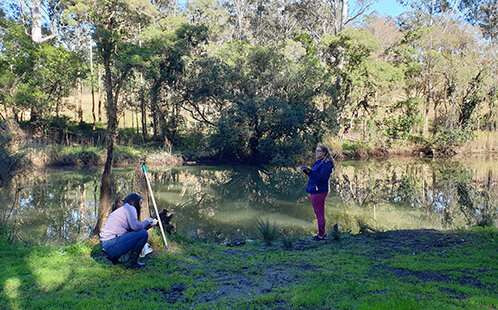Western Sydney University student Gabrielle Sabatino and PhD Candidate Katherine Morrison collecting water samples. Credit: Western Sydney University
A pilot study of one of Australia's most elusive creatures, the platypus, has revealed they are living in unlikely, urban locations in Sydney.
A research team from Western Sydney University and Cattai Hills Environment Network (CHEN), with the help of volunteer citizen scientists and students, collected 41 water samples from catchment areas stretching from Cattai to Castle Hill.
Dr. Michelle Ryan from the University's School of Science said the samples were tested for traces of platypus Environmental DNA (eDNA) – with some surprising results.
"24 percent of the samples contained DNA evidence that platypus were in the waterways," said Dr. Ryan.
"These positive samples were taken from 44 percent of test locations. Interestingly, it was in the more urban areas, in close proximity to roads or properties, that we detected the traces of platypus DNA. In the more remote areas, away from major roadways and developments—where the habitat and conditions appeared to be better, and you'd think it would be more likely for platypus to be living—we found no DNA traces."
Dr. Ryan acknowledged that, for indications of a healthy population, DNA should be present in 80 percent of the samples. However, she said the results were still a positive sign.
"It is relatively unknown that we have platypus in the Sydney Basin—so it was good to see that they are here, and they may be able to withstand the pressures of a growing city," she said.
Sue Martin, Chair of CHEN, said the testing sites were chosen based on reports from members of the community, who had previously sighted platypus in the area.
"We received accounts from long-term locals that platypus seemed plentiful in local waterways in the past. It is fantastic to be able to confirm that they still occur in the area, but the study does raise more questions than it does answers," said Ms Martin.
"More testing is required to get a better understanding of why they live in the areas that they do, and how we can ensure that this iconic species flourishes in the Sydney Basin into the future."
The pilot study was funded under the local government Communities Environment Program, and will contribute towards the development of a conservation strategy for platypus in the region.
The team at Western Sydney University and CHEN are seeking additional funding to conduct further sampling; extend the project throughout the Hawkesbury and Hills areas; and establish community education and habitat restoration programs.
Provided by Western Sydney University
























